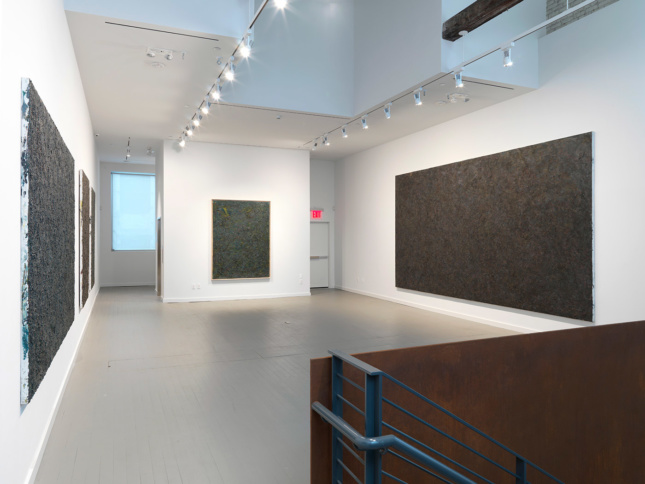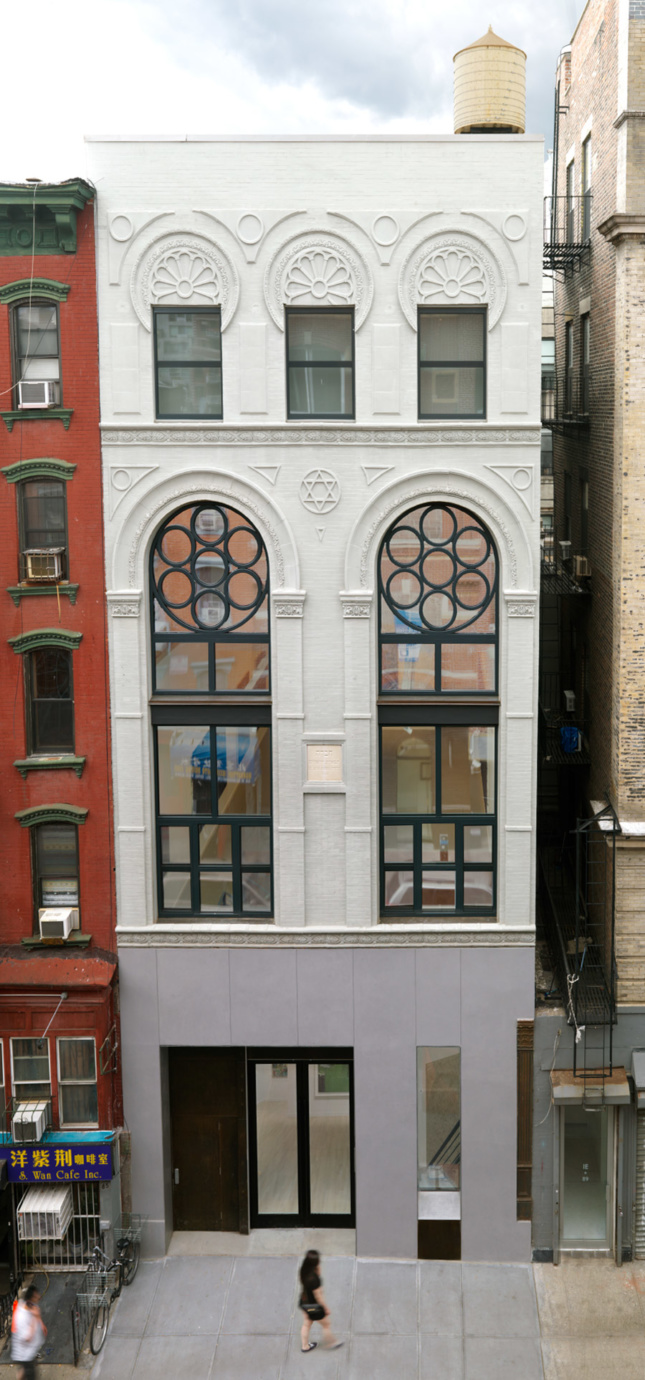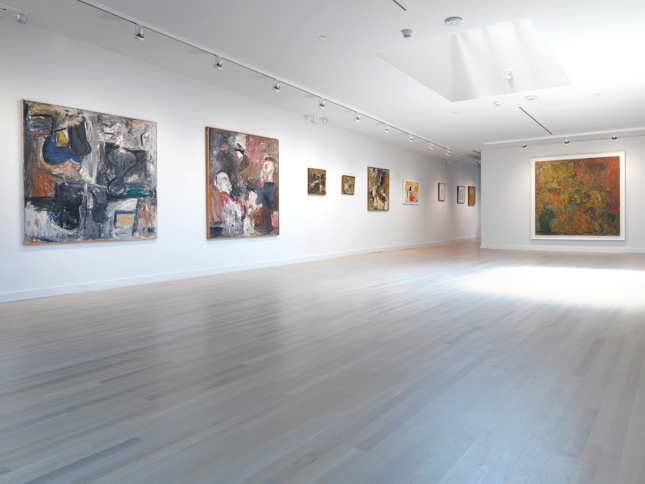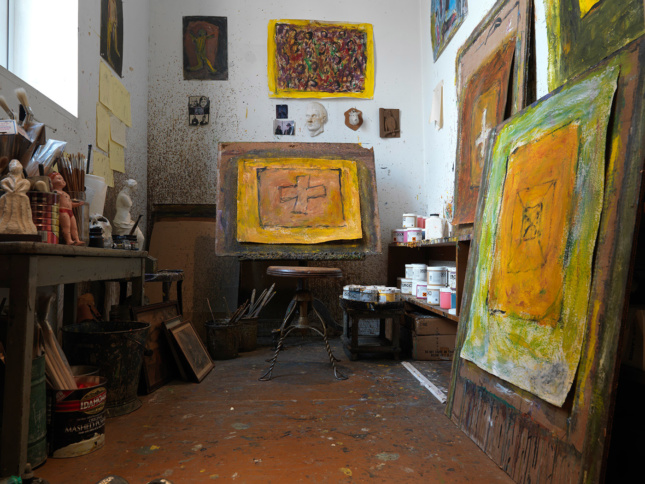Free and open to the public, the Milton Resnick and Pat Passlof Foundation on Lower Manhattan’s Eldridge Street will open to the public on September 15 and 16. The art space is housed in a former synagogue where Resnick (1917-2004) lived and worked, while his wife Passlof (1928-2011) had her own converted synagogue one block over on Forsyth Street. Resnick was one of the original Abstract Expressionist painters and was close friends with Willem de Kooning, through whom he met his wife. Although the foundation is focused on their work, it will also present exhibitions of other artists, readings, performances, and lectures, and welcome scholars.

The renovation by Ryall Sheridan Architects attempted to keep the spirit and openness of Resnick’s studio while bringing it up-to-date with such improvements as an elevator and modern-day climate-control. Whereas the original studio was dark and enveloping—it included a double-height space with bare brick walls, kept wide open for large-scale painting without furniture or lighting—the new Foundation is light and open. With blonde-and-gray slat wood floors, white walls, LED track lighting, slate-gray metal staircases, riveted Corten steel plates, exposed brick walls, white scrim blinds, wood joists, silver-handled door pulls, and Duravit sinks in the bathrooms, it has the animus of a Chelsea art gallery. The only traces of its ecclesiastical past are the tall windows in the double-height exhibition space on floors two and three (formerly the painting studio and before that the temple assembly), which are capped with round windows and three carved rosettes on the exterior’s top floor facade along with the inscription of the synagogue’s name and date.

The building, originally a tenement, was purchased in 1888 and converted into Bnai Tifereth Yerushalayim (Sons of the Glory of Jerusalem) and the Mesivta Tifereth Yerushalayim. The congregation removed the third floor to create the tall sanctuary, and Resnick later removed the women’s balconies. In the 1960s, a Syrian Orthodox church bought the building, flipped it to the Lincoln African Methodist Episcopal Church, who then sold it to a developer, who converted it into a warehouse and later sold to Resnick in 1977. Passlof’s 1874 synagogue, which the couple purchased in 1963 for $20,000 when it was condemned, was home to Kol Israel Anshe Poland, which installed Gothic windows and fire escapes sporting Stars of David. Passlof’s Forsyth Street building was sold in 2012 for $6.4 million to fund the renovation of the Eldridge Street building. It can be viewed from the back windows of the Foundation, along with new skyscrapers ranging from One World Trade Center, the Herzog & de Meuron tower on Leonard Street, the Gehry Tower on Spruce Street, and a new hotel in Chinatown peeking above the skyline.

In fact, the entire Lower East Side neighborhood is still filled with relatively small houses of worship on side streets: the Kehila Kedosha Janina Synagogue and Museum at 280 Broome Street for the Romaniote Jews of Greece, the Angel Orensanz Center at 172 Norfolk Street, Bialystoker Synagogue at 7 Willett Street, Congregation Sons of Moses at 135 Henry Street, Stanton Street Shul at 180 Stanton Street, Congregation Chasam Sopher at 10 Clinton Street, and the granddaddy of them all, the Eldridge Street Synagogue with Kiki Smith and Deborah Gans Rose Window at 12 Eldridge Street.
Resnick was born in Ukraine, then part of Russia, the year of the Russian Revolution in 1917. His Jewish family emigrated to the U.S. in 1922, and he studied at the Hebrew Technical Institute in New York City with the intention of becoming an architect. Because the Depression stifled construction, he switched to Pratt for commercial art, then to the American Artists School for fine art. After working for the WPA Federal Art Project, he was drafted into the Army during World War II and studied in Paris afterward. There he met Giacometti, Brancusi, Tristan Tzara, and other art-world luminaries. On his return, he moved into a studio on East 8th Street, where de Kooning, Franz Kline, and Jackson Pollock worked. During the summer of 1948, he first met Passlof, a student of de Kooning’s, who told her Resnick was the individual he “respects more than any other.”

The work in the inaugural display, Milton Resnick: Paintings 1937–1987, shows his paintings and drawings, ranging from colorful figurative works to large-scale monochromatic pieces. As he became infirm, Resnick confined himself to the third floor where he worked in a converted closet. This small studio has been preserved with paint splatters, images of Rasputin tacked to the walls, family photos, bas-reliefs of faces and animals, a Polaroid of a tree, Chinese sculpture, his own doodling, jars of paint, cans of brushes, bottles of ink, and a pair of rubber slippers.











